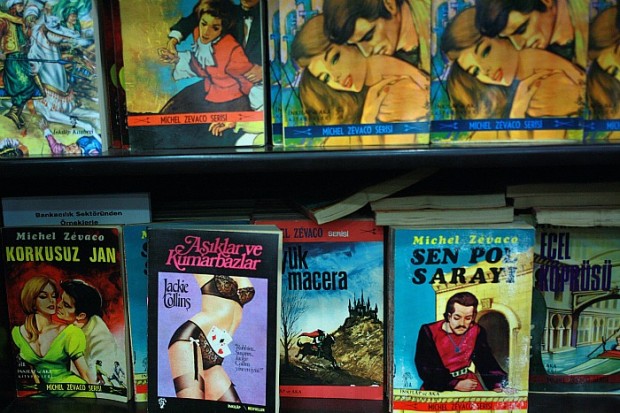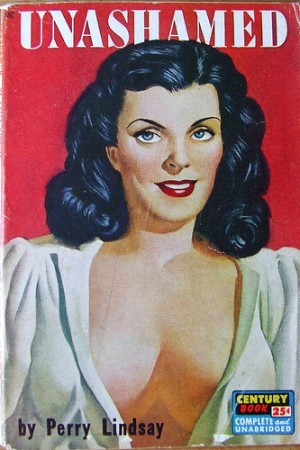You have no items in your cart. Want to get some nice things?
Go shopping
What is the role of literature in the transgressive world of pornography today? Do dirty words still have the power to shock and offend, as well as titillate? Helen Hester, a scholar with a doctorate in contemporary understandings of the pornographic, argues that the influx of apparently harmless “mommy porn” on the literary scene is only part of the story: the naked word remains far from respectable.
The days when a sex scene in a book could generate wide-spread controversy are long gone. Now that you can pick up a copy of E. L. James’s Fifty Shades of Grey along with your groceries, the pornographic written word appears to have lost its power to shock. When dirty books can arouse our interest, but not our outrage, can we still consider them pornographic?
Our response to this question depends on what we mean when we use the term “porn” – a word notoriously difficult to define. One argument claims that pornography cannot be simply characterized as an area of culture with clear and firm boundaries; a distinct set of texts featuring particular acts or body parts. Porn would therefore refer to a different variety of sexual materials, grouped together because they are all considered to be in some way culturally problematic.
In his book The Secret Museum: Pornography in Modern Culture, the literary critic Walter Kendrick refers to pornography as “an imaginary scenario of danger and rescue, a perennial little melodrama”. This pornographic scenario posits a certain bracket of society (demarcated, as we know, along classed or gendered lines) as vulnerable and in need of protection from sexually explicit materials and their possible effects. Despite the fact that this description encourages critics to discuss porn and its impact only in abstract terms, without reference to its content, it remains a clear and insightful take on pornography’s structural position in relation to mass culture. Porn, according to this argument, is that which is seen as a bad influence, and this is reflected in organized attempts to censor it.
How does literature fit with such a characterization today? Dirty words have of course received their fair share of censure but, as Kendrick pointed out way back in 1987, “None of the recent major battles over pornography has involved the naked word, and it seems unlikely that any future Ulysses or Lady Chatterley’s Lover will be able to arouse the fury those books caused when they were new.” Sexually explicit writing can still tease, stir, and titillate, no doubt, but it seems far less likely to prompt efforts at policing and regulation. Instead, the focus has shifted onto graphic sexual imagery, which continues (in both its still and moving forms) to attract attempts at censorship. Whilst many aspects of adult entertainment are becoming increasingly visible within contemporary culture, there is still a pervasive anxiety about the impact of certain kinds of images upon certain types of “vulnerable” audiences.
Sections 63 to 67 of the UK Criminal Justice and Immigration Act 2008, for example, criminalized the possession of so-called “extreme pornographic images”; that is, photorealistic depictions of any act which appears to threaten a person’s life, involves necrophilia or bestiality, or may result in “serious injury to a person’s anus, breasts or genitals.” The negative effects of porn upon children, meanwhile, continue to be much-debated, and moral panics surrounding the issue are never completely off the horizon. A 2008 episode of Channel 4’s The Sex Education Show, for example, addressed the topic of digital visual pornographies, opening with the claim that Britain has “the worst ever rate of sexual diseases among young people; over twenty school girls get pregnant every day; and, most alarming of all, teenagers have unlimited access to extreme pornography.” The idea of young people’s unfettered access to online porn is here presented as eclipsing numerous (unwanted?) pregnancies and even the transmission of STDs in terms of its impact upon the health of the nation. If we take cultural unease and attempts at censorship as a barometer of a text’s status as pornographic, then it would seem that the image has largely superseded the word.
This idea is to some extent reflected by the mainstream media response to the Fifty Shades phenomenon; its explicit depictions of Ana Steele and Christian Grey engaging in BDSM-inflected sex are not described as porn per se, but as “mommy porn”. The introduction of this prefix mitigates and qualifies, suggesting that these written texts are not dangerous or inflammatory, but banal, acceptable, domestic. Even within a contemporary culture that loves to vaunt the supposedly radical possibilities of sexual transgression, the books fail to meet some standard of appropriately pornographic naughtiness. Of course, the “mommy porn” label may simply be meant to characterize the books’ readership – the Collins English Dictionary defines it as “a genre of erotic fiction designed to appeal to women” – but the terms also conflates ideas about gender and form. It may be that linguistic pornography is perceived as being less culturally problematic (that is to say, less pornographic) than its image-driven counterpart because it is more typically associated with an adult female audience. After all, as Jane Juffer points out in her book At Home With Pornography, “erotic fiction” has historically been particularly accessible to (and associated with) women.

Written forms of the sexually explicit are seen as being for women, whose sexuality is not perceived as posing the same kind of social problems as that of the corruptible child or the potentially violent male, and whose enjoyment is assumed to be predicated upon the pleasures of a conventional, Mills & Boon-style romance narrative. As the “mommy porn” label suggests, a woman’s desire – especially a mother’s – is not seen as predatory or transgressive, but as cosy and possibly slightly laughable. Even James’s focus on the supposedly taboo pleasures of BDSM fails to inject any sense of danger into proceedings.
It is interesting, I think, that the promotional blurb for Fifty Shades seeks to align the books themselves with their titular male protagonist; James’s website states that the trilogy is “a tale that will obsess you, possess you, and stay with you forever,” giving all her grateful readers a little taste of the Christian Grey treatment. In fact, the books are usually positioned (at least in the press) as more Steele than Grey – if not entirely without charms, then at least silly, non-threatening, and somewhat pathetic. This variety of the sexually explicit written word, associated as it is with a particular gendered sphere of reading, has not been seen as beyond contempt, but it is clearly not a cause for wide-spread and deep-seated cultural unease. We can see, then, that pornographic fiction is no longer pornographic by certain established criteria. Having been largely domesticated, it is no longer considered a receptacle for anxiety, or a target of critique, and is distanced from the “little melodrama” of rescue-through-censorship by which Kendrick understands porn.
Today’s dirty books have elsewhere been thought of as somehow a curiosity or an anachronism. Here porn is considered to have made a kind of rake’s progress through the written word, engravings, photography, and film to moving-image digital materials that can be located, disseminated, and consumed via the screens of our personal devices. Adult entertainment has famously been linked to the development of consumer electronics and business technologies; the pornographer, one could argue, is the quintessential early adopter. As David Slayden notes in his work on adult entertainment and market innovation, the porn industry has been “quick to exploit each new technology” that’s come along, from the printing press to the VCR. More recently, he argues, consumer demand for porn has even “driven the development of servers, streaming software, chat forums, and e-commerce payment systems,” with porn users actually accelerating the development of technologies that make even the less stimulating elements of life online easier and more efficient.
The cultural visibility of new media, combined with its unknown qualities and capacities, facilitates a wave of fresh and urgent concerns about pornography, its availability, and its impact. Porn’s use of emerging technologies therefore links with Kendrick’s claims about porn as, by definition, a culturally dangerous realm, deserving of censorship. If we assume that pornography is a genre proceeding along a clear and linear path of development, in line with the progression of new technologies, then of course the humble mass market pornographic paperback has to some extent slipped from view.
However, the diminishment of a form’s cultural visibility does not equate to total disappearance and, to quote the Porn Studies scholar Susanna Paasonen, a “tendency to understand porn in terms of the visual […] fails to account for the diversity of contemporary practices.” One could argue that dirty words are still thriving. Quite aside from the success of particular books and imprints, the written word continues to play a role within digital porn cultures, and there are massive banks of fan fiction, personal fantasy, and erotic stories available online. Additionally, textual language is present and remains crucial to our experience of internet porn even in its visual forms. As consumers, we not only frame our quest for images with appropriate search terms, but typically encounter visual material alongside linguistic descriptors, like captions for example. Paasonen has noted that these descriptors often rely on hyperbole, positioning the sexual acts depicted as “markedly fractious, laborious and potentially violent,” whilst emphasizing the “interfacing of the colossal and the miniscule.” Bodies, according to this language, are “stretched” and “slammed”, “ripped” and “reamed”.
The words surrounding digital pornographic imagery, I would argue, act not simply as titles or captions, but as what Roland Barthes would call “anchorage”. That is to say, they attempt to fix the meaning of the polysemic image, shaping and even policing our interpretation, and frequently encouraging the viewer to see domination, violation, and exploitation within materials which might not otherwise prompt such hostile readings. Textual language, then, can be thought of as a kind of pornographic intensifier; indeed, it may be partially responsible for porn’s reputation as a hideous quagmire of misogyny. Today’s sexually explicit written word is therefore not as uncontroversial as the “mummy porn” movement might suggest. In the digital world it continues alongside the more culturally visible image-based forms of pornography. Despite its position having been transformed, it remains unsurpassed in the course of the genre’s evolution.
However, whilst explicit linguistic texts continue to exist in print and online, many do not so easily fit Walter Kendrick’s working characterization of pornography. If one were to accept his viewpoint in The Secret Museum, such examples are graphic without being pornographic. Indeed, one of the major limitations of Kendrick’s take on porn and/as cultural policing is that it excludes so much explicit material that has ceased to provoke significant protest. To count as porn only that which suffers from (or enjoys) heightened public hostility is certainly provocative, but it risks overlooking the more subtle relationships and disjunctions between forms of the explicit that provoke censure and those that do not. His definition of porn begins to look over-simplistic.
It is therefore worth remarking that there has been something of a resurgence of legal interest in the sexually explicit written word in recent years – a resurgence that is at least in part driven by the intersection of the linguistic and the digital. As we’ve seen, new media often provoke new anxieties, and the possibilities of online distribution mean that the word has been revivified, and its perceived dangers reactivated. There have been several cases in which written materials have found themselves in the spotlight. In Pittsburgh in 2008, for example, the woman behind the website Red Rose Stories – an online repository of written fiction about child abuse – pleaded guilty to obscenity trafficking. In the UK, meanwhile, a man faced prosecution under the Obscene Publications Act 1959 for writing an explicit blog post about the rape and dismemberment of the pop group Girls Aloud. The man in question was cleared in June 2009, but cases like this indicate that concern about pornography goes beyond the use and potential abuse of real bodies, and extends to offence and anxiety caused by textual fantasies – specifically, “extreme” sexual fantasies that can be distributed and accessed with apparent ease in the digital age.
In the examples above, the discomforting nature of the content coincides with cultural anxieties about the form. In the case of the Girls Aloud post, for example, the decision to prosecute was explicitly linked to the digital mode of distribution, with the prosecuting counsel stating that “the article in question, which was posted on the internet, was accessible to people who were particularly vulnerable”. Here we are once again confronting a scenario of danger and rescue. Within certain frameworks and in the right (wrong?) context, sexually explicit language can be seen to retain what Kendrick would consider to be its pornographic force. Just as the digital revolution has forced us to reconsider what a book is, so does it change our perception of porn. The relatively free circulation of materials online – their perceived ability to circumvent restrictions, to cross national and legislative boundaries, and to reach a wide range of people – means the pornographic written word is once again problematic, its transgressive potential rediscovered. However one chooses to define pornography, then, the written word cannot be undermined: Joyce and Lawrence may no longer press our cultural buttons, but the naked word remains far from respectable.

About Helen Hester
Helen Hester is Senior Lecturer in Media at Middlesex University, working from the international branch campus in Mauritius. Her research interests include pornography, visual culture, and sexuality studies, and she is the author of Beyond Explicit: Pornography and the Displacement of Sex (SUNY Press, 2013).





…and Dirty Books: Pornography, Censorship, and the Naked Word over @LitroMagazine
https://t.co/Cx0CtYV6iy
Another piece on pornography by @HelenHester a contributor to our Porn & Sex in Cinema issue https://t.co/5iDoedLSa9
In case you missed it here’s a critical appraisal of mummy porn by @helenhester @litromagazine https://t.co/8CFr5Ta0Tr